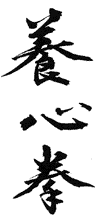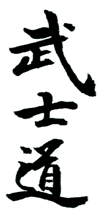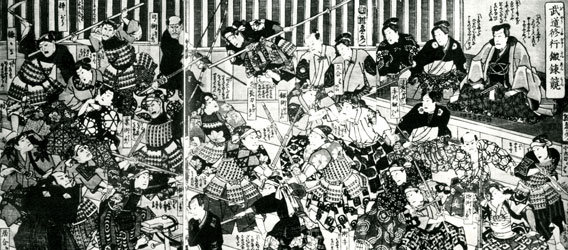| |
What does this mean to us today ?
Over the centuries, original descriptions and meaning are quite often
lost, and the above headings are no exception. I would like to give my
perspective and try to give those who are kind enough to read this
through some thoughts which may make an explanation possible.
A military force to be successful must have apart from their weapons,
use, and tactics, a very strict discipline, a code of honour and
allegiance to their highest officer and country.
These are the necessary basics which are in:
“Bushido”= The Way of the
Japanese Warrior
Certain weapon disciplines such as using the sword, halberd, bow &
arrow, staff, knife etc. also grappling, strikes, kicks, attacking
vital points in unarmed combat, when the weapons have been dropped, or
broken, can be called :
“Bujutsu” = Classical Martial
Arts of Self-protection
Today many fighting disciplines exist both with and without weapons,
many of these are grouped together under a common name of:
“Budo”= Classical Martial Ways of
Self-perfection
Since Budo has become the modern interpretation of the Way of the
Warrior which received its acceptance after World War 2 as a character
building system with high discipline through the training with weapons
and associated unarmed combat, the main goal being to develop a high
moral, honesty, respect all the aspects of a good citizen, but not the
training of a professional soldier.
A thorough warm-up programme,
training in perfect conditions, tournaments, these were definitely not
part of the old way, and the professional warrior did not have these
luxuries.
So already here a considerable difference can be seen between
Bushido/Bujutsu and modern day Budo and so-called Martial Arts –
Martial Way is a more appropriate name.
So what has come from the old original training and way of the
“samurai” ?
In answering this I must use the written words of two highly respected
masters “sensei” of their time Yamamoto Tsunetomo and Donn F.Draeger.
The first - Yamamoto Tsunetomo born 1659 was samurai turned Zen monk
who through his devoted student “deshi” Tashiro Tsuramoto dictated a
collection of approximately 1300 lessons and examples related to the
way of the samurai.
This was compiled into 11 volumes and called:
“The Hagakure” (Behind the
Leaves) - A Code to The Way Of The Samurai.
Very deep in meaning this work showed the bond between Lord and
Retainer with a supreme form of loyalty which is very difficult to
understand or even accept today.
Confucianism plays an important part,
and Zen´s emphasis upon fortitude and discipline is understood
completely by the samurai who must focus 100% on combat and nothing
else.
|
|
A few examples of this code :
• Know the meaning of Bushido
• Complete, without exception loyalty to ones Lord/Master
• Be prepared for every situation
• No end to lifelong training
• To know the limit of ones wisdom
• To show tact when correcting others shortcomings
• Be a considerate guest
• Cover a yawn
• How to fight in a street fight
• Give words of encouragement
• Be resolute
• Look in the mirror – appearance-clothing-personal hygiene
• Careful of your words and language
• Learn by observing
• Be pure and simple ( not complicated )
• Fear not the rain
• Raise a samurai´s child properly
• Observers see more than the players
• Think not of yourself as established
• Know your limits and capacity
• Fear not failure
• Move heaven and earth
• Be always modest as though first met
• Never be slain in the back
• The Four Pledges:
1. Never be behind the others in the pursuit of Bushido
2. Make your self useful to the Lord/Master
3. Discharge your filial duties
4. Labour for the good of others with a most benevolent soul
To each and every quotation is given an explanation or example.
Reference :
The Hagakure – A Code to the Way
of the Samurai
Yamamoto Tsunetomo
Translated by Takao Mukoh
ISBN 0-89346-169-5
Secondly in more modern times Sensei Donn F. Draeger (1922-1982) – the
first and only non-Japanese to hold the rank of “budo kyoshi” or full
professor of the classical martial arts and ways. Sensei was also the
creator of the recognised academic discipline of hoplology ( the study
of weapons and fighting systems ) with the International Hoplological
Research Center and published its newsletter. He held high dan grades
in many disciplines.
Sensei Draeger gives a much better picture than I of how modern Budo
developed as he was personally involved in the very critical period
after World War 2 when it was very uncertain if the Japanese would be
allowed to continue training in the way of the samurai.
The incredible interest shown to date not only in Japan and Asia but
throughout the world
where Jujutsu-Judo-Kendo-Aikido-Iaido-Kyudo-Kobudo-Kenpo, the many
styles of Karate from Japan, Wushu-Kung-fu-Shuai Jiao from China,
Silambum-Kalari Payattu & the fighting arts of India and Burma,
Muay Thai from Thailand, Tae Kwon do from Korea, Silat from Malaysia
& Indonesia, Escrima-Kali from the Philippines, Capoeira from
Afro-Brazil altogether have millions of devoted practitioners.
Reference :
Classical Budo Volume 2 – The
Martial Arts & Ways of Japan
Donn F. Draeger
ISBN 0-8348-0086-1
Modern Bujutsu & Budo Volume
3 – The Martial Arts & Ways of Japan
Donn F. Draeger
ISBN 0-8348-0099-3
Asian Fighting Arts – Donn F.
Draeger / Robert W. Smith
ISBN 87011-079-0
All the major karatedo and other ryu or systems have a strict code of
behaviour, with detailed etiquette rules as to how one should act in
the training hall “dojo” even reciting a training oath “dojo kun” after
every training session, there are set social etiquette rules of how the
karateka should behave away from his or her dojo.
If the code of
behaviour is broken in the dojo a reprimand is given by the instructor
“sempai-sensei-shihan” in the form of pushups, squats, punching/kicking
a bag, or sitting on the knees “seiza” - physical punishment or to
contemplate what went wrong, and to renew ones attitude and effort. A
good instructor will probably listen and talk with the student
depending upon the severity of the mistake.
Marshall McDonagh
Kyoshi Taikiken
Yoshinken Sweden
29th May 2005
|



